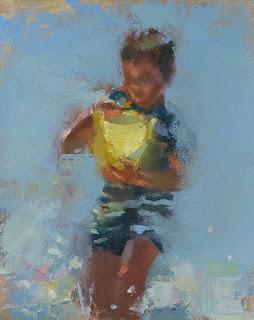 Yellow Pail10 x 8
Yellow Pail10 x 8Oil painters spend a lot of thought and time doing something that watercolour painters do in a second: we try to create large, simple passages of paint that maintain color and feel rich, rather than thin and greyed. And that's because oil paint doesn't work well in very dilute form. You can't create a wash unless you add a lot of medium to it which is something that I avoid. If the medium is relatively safe - like my 50/50 OMS and oil - it makes the paint look meagre and dilutes the pigment so much that the color dies. If the medium is one of the many pre-prepared variety, it has a lot of technical and health issues that I don't want to bother with:
- how fat or lean is the mixture? This matters in building a sound painting.
- will it damage my health to use it in the studio, day after day? I've tried mediums that leave me staggering drunkenly by the end of a painting session, and I can't afford to lose that many brain cells.
- is it hard to clean out of my brushes, thereby risking my treasured and expensive supply of Rosemary's?
- is it solid in the long term? Rembrandt used linseed oil, so I know I'm on well trodden ground with that. Yes, he didn't have OMS, but I draw the health line at using turpentine indoors. Even OMS is very toxic, so I make sure to use a high quality brand with a very low evaporation rate such as Gamsol.
The best paint film is one that's been adulterated the least, and that means as close to tube consistency as possible. That also makes the best colour, which is a priority for me.
So, with all that in mind, how does a painter make a smooth, simple area, rather than one that's choppy and brushy?
The answer that I've come up with is to use fairly thick paint and use mechanical means to smooth it.
One of my favorite tools for that is a palette knife. If an area of paint is too sculptural and busy, I lay my knife flat on the surface of the paint and make gentle circles. Any angling, or dried bits of paint on the knife will cause scratches in the paint surface, so this is a delicate maneuver. If your knife has dried paint on it, you can place it flat on some sand paper and smooth them away. This method allows you to keep your color intact and even to use thick paint but leave it looking smooth and colourful.
Another useful method is to scrape it out with a soft tool like a silicone scraper or shower squeegee. Again, it lets you use a lot of paint and colour, but, if your scraping surface is large enough, you can pull the paint quite a distance and create a smooth effect. The edges will be distinctive and recognizable in this method; everyone can recognize a squeegee effect because so many painters have been using it in the past few years.
I've also had some fun with Whistler's method. He loved to scrape paintings down between sessions, losing the brushwork but keeping a thin layer of pigment. Over many sessions, that pigment layer became a soft, atmospheric, and smooth patch of paint. His work looks a bit too thin for my eye but a lot of painters have and do use this method and leave more paint behind during the scraping.
And then there are other methods: brayers, rollers, rolling pins over plastic wrap or waxed paper, and, I'm sure, many more.
If you work wet on dry, it's easier to turn a busy area into one that appears smooth and simple, because the new paint grabs dry paint in a way that it won't grab a primed canvas or board. There's just the right amount of flow and adhesion. It's a pleasure to work on.
The piece above has a lot of different methods used on it to create that large mass of blue. It's painted alla prima, and has high pigment load, as well as color variety within the blue, so you probably figured that I couldn't have done it with a lot of dilution, and I didn't. Instead, I placed a lot paint and smoothed it with the knife, brayer, and, to a lesser extent, with a soft brush. That's a thick area, but it doesn't look sculptural and it doesn't distract from the figure.
So, before you dip into that pot of medium to get your paint moving, consider all the mechanical means instead. You'll end up with some interesting effects, and much better colour, even if you, like me, work in a lot of layers.
Happy painting!

